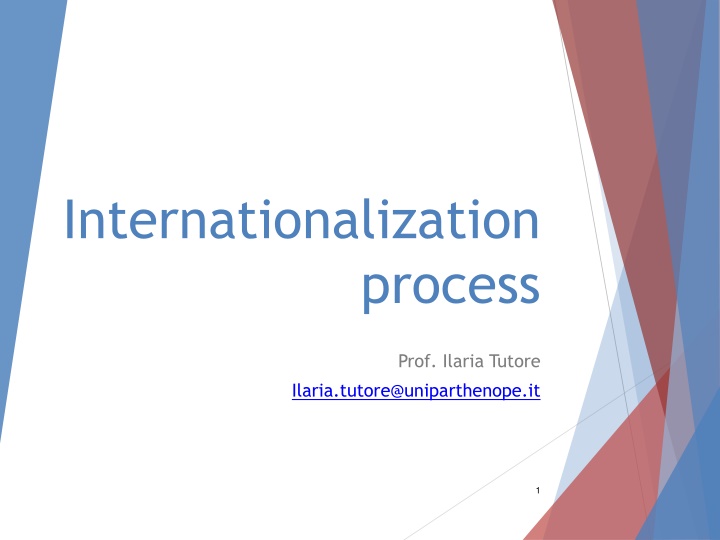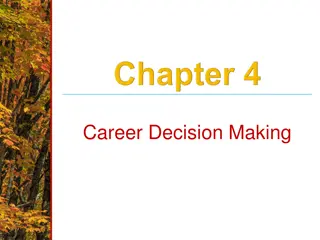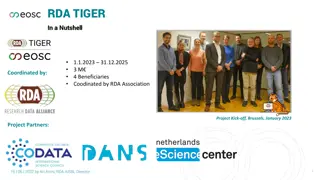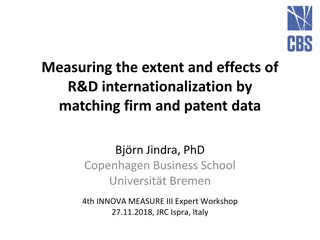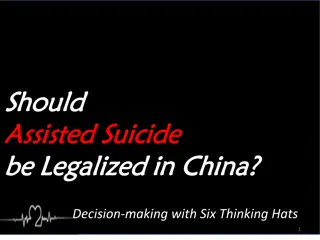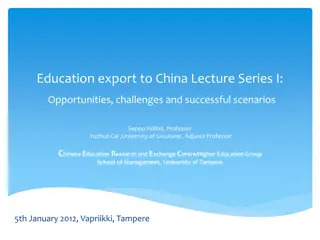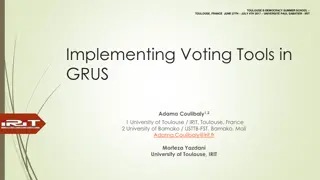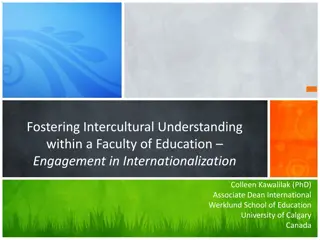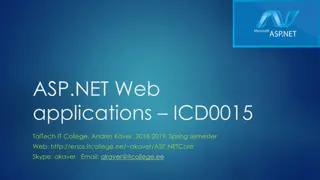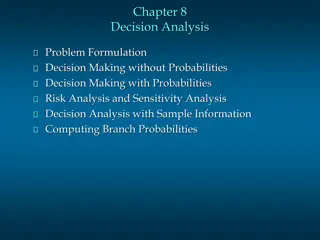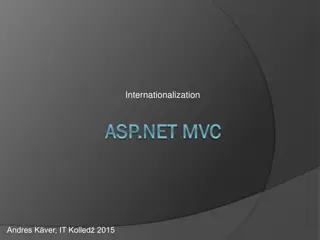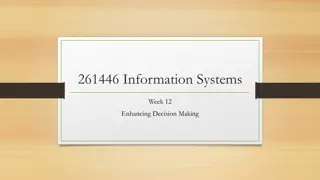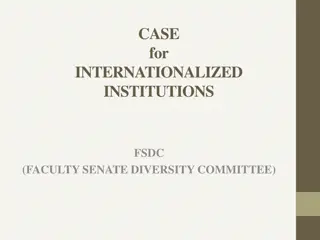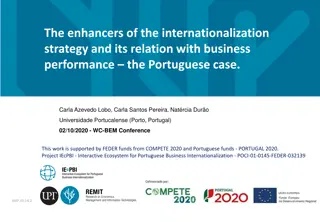Internationalization Process and Strategic Decision-Making
This content delves into various aspects of internationalization, strategic decision-making, and the challenges and opportunities businesses face in global expansion. It covers topics such as drivers of firms' internationalization, growth strategies, VUCA environment, competition, strategy formulation, and the steps involved in the internationalization process. Additionally, it discusses the importance of identifying target markets, evaluating risks, selecting entry modes, and the advantages and disadvantages of being a first mover in international markets. The information provided is valuable for businesses looking to expand internationally and make informed strategic choices.
Download Presentation

Please find below an Image/Link to download the presentation.
The content on the website is provided AS IS for your information and personal use only. It may not be sold, licensed, or shared on other websites without obtaining consent from the author.If you encounter any issues during the download, it is possible that the publisher has removed the file from their server.
You are allowed to download the files provided on this website for personal or commercial use, subject to the condition that they are used lawfully. All files are the property of their respective owners.
The content on the website is provided AS IS for your information and personal use only. It may not be sold, licensed, or shared on other websites without obtaining consent from the author.
E N D
Presentation Transcript
Internationalization process Prof. Ilaria Tutore Ilaria.tutore@uniparthenope.it 1
Drivers of firms internationalization External drivers Internal drivers
Internationalization as a growth strategy Way (What?) Growth vectore Direction (+/-) Intensity (level of target) Entry Mode How? Organization types Allocation of resources Circular process strategy/entry mode 3
Vuca stands for Volatile: Things change continuously (leaders and followers change continously) Uncertain: We live with a lack of predictability (vintage) Complex: Simple cause-and-effect chains have been replaced by complex interconnections Ambiguous: what is true? whai is wrong? 4
Competition requires GOOD STRATEGIC CHOICES DEFENDABLE AND SUSTAINABLE COMPETITIVE ADVANTAGE STRONG RELATIONSHIPS Competitive cooperative SOLID BARRIERS 5
Strategy formulation Internal analysis External analysis Strategic goals Implementation 6
The internationalization process Firms expanding internationally must decide: which markets to enter when to enter them and on what scale which entry mode to use 1. External analysis 2. Internal analysis 3. definition of goals 4. implementation 7
The main steps Identification of target countries. 2. Decide on the specific area in which to implement its strategy. 3. quantify or at least estimate the major risks that characterize them. 4. Evaluate the most suitable entry mode into the given market. 1. We need to evaluate: market opportunities available resources desired results flexibility 8
The first mover Advantages Disadvantages High exploration costs High problem solving costs Uncertainty about demand Brand loyalty Control of lacking resources Higher revenues Building up of switching costs for clients High probability to survive in the long term 9
Environmental Factors Affecting Organizations
There are many tools available to conduct an external and internal analysis of the current environment in which an organization operates. The most useful for building are: PEST Analysis (external environment) SWOT Analysis (internal & external environment) The results of these strategy analysis tools should be used to review the lobbying objectives set for the organization. Where necessary, the objectives will be amended to reflect the reality of the current situation. However, more often the analysis affects how the objectives are achieved rather than resulting in a change of objectives.
PEST ANALYSIS find out the current external factors affecting an organization; identify the external factors that may change in the future; to exploit the changes (opportunities) or defend against them (threats) better than competitors would do. The outcome of PEST is an understanding of the overall picture surrounding the company
Political Factors The current and potential influences from political pressures SOME EXAMPLES: When is the country's next local, state, or national election? How could this change government or regional policy? Who are the most likely contenders for power? What are their views on business policy, and on other policies that affect your organization? Could any pending legislation or taxation changes affect your business, either positively or negatively? How will business regulation, along with any planned changes to it, affect your business? And is there a trend towards regulation or deregulation?
Economic Factors The local, national and world economic impact SOME EXAMPLES: Are key exchange rates stable, or do they tend to vary significantly? Are customers' levels of disposable income rising or falling? How is this likely to change in the next few years? Do consumers and businesses have easy access to credit? If not, how will this affect your organization? How is globalization affecting the economic environment? Are there any other economic factors that you should consider?
Sociocultural Factors The ways in which changes in society affect the project SOME EXAMPLES: What is the population's growth rate and age profile? How is this likely to change? Are generational shifts in attitude likely to affect what you're doing? How do religious beliefs and lifestyle choices affect the population? Are any other socio-cultural factors likely to drive change for your business?
Technological Factors How new and emerging technology and technology landscape affects the project SOME EXAMPLES: Are there any new technologies that you could be using? Are there any new technologies on the horizon that could radically affect your work or your industry? Do any of your competitors have access to new technologies that could redefine their products? How have infrastructure changes affected work patterns (for example, levels of remote working)? Are there existing technological hubs that you could work with or learn from?
Issues of concern The main problem with these external PEST factors is that they are continuously changing Therefore PEST analysis should include a thorough analysis of what is affecting the organization or a project Now, and what is likely to affect it in the Future The result of a PEST analysis is usually a list of positive and negative factors that are likely to affect a project However, by themselves, theses factors they mean very little It is important to bear in mind, that PEST analysis requires careful Application of results
Similar analysis PESTLIED PEST PESTLE STEEPLE SLEPT
Microeconomic analysis Step 1 Step 2
Internal Resource Analysis Evaluate firm s current managerial, technical, material, and financial resources and capabilities to assess its strengths and weaknesses. Take advantage of international market opportunities Match external opportunities (gained in environmental scan) with internal capabilities (gained through internal resource analysis) Evaluate firms capacity to attract and to manage new resources internal vs external development
SWOT ANALYSIS The aim of any SWOT analysis is to identify the key internal and external factors that are important to achieving the objective. SWOT analysis groups key pieces of information into two main categories: Internal factors The strengths and weaknesses internal to the organization. External factors The opportunities and threats presented by the external environment to the organization. A PEST analysis helps to identify external factors.
Choice of Entry Modes Control relationship Export/Import Cooperative relations (strategic alliances) Wholly Owned Subsidiary Mergers/Acquisitions Alliances and Joint Ventures Market relationships Licensing Franchising Countertrades
BORN GLOBAL FIRMS According traditional internationalization theories (Uppsala model) firms first target the domestic market and then internationalize gradually to culturally similar nearby countries. BORN GLOBAL FIRMS
BORN GLOBAL FIRMS: CONCEPTS AND DEFINITION Different concepts have been associated with the phenomenon Several definitions have been provided by management literature Rennie (1993) identified the follow characteristics: They exported at least 25% of their production and started exporting no later than two years after their inception The management looked on the world as one market Companies were relatively small with a turnover under $100 million The main part of Born Global companies was created by active entrepreneurs and was mainly based on a technical breakthrough They applied leading-edge technology either in manufacturing or in the way that they were doing business The products that Born Global companies offered were mainly addressed to other companies According to Ingerman (2006) is a A company that has achieved a foreign sales volume of at least 25% within three years of its inception and that seeks to derive significant competitive advantage from the use of resources and the sales of outputs in multiple countries
MAIN FEAUTURES OF BORN GLOBAL FIRMS 1. High activity in international markets from or near the founding 2. Limited financial and tangible resources 3. Present across most industries 4. Managers have a strong international outlook and international entrepreneurial orientation. 5. Emphasis on differentiation strategy 6. Emphasis on superior product quality 7. Leveraging advanced information and communications technology (ICT) 8. Using external, independent intermediaries for distribution in foreign markets.
FRAMEWORK OF BORN GLOBAL Entrepreneurs BORN GLOBAL Network Industry Globalization Source: Andersson and Wictor, (2003)
BORN GLOBAL: SECTOR OF ACTIVITY Source: Eurofond
The role of Ecosystems in technology sector 1.The first type of ecosystem is anchored around universities and firms operating in the same industry as the focal firm 2.The second type of ecosystem establishes and strengthens relationships between the local operations of firms and their foreign sales subsidiaries 3.The third type of ecosystem is anchored around foreign sales subsidiaries and local clients that are important for high-quality service.
PHASES OF GLOBAL START-UP ASSESSMENT Do I want to build the brand around the world right from the start? Do I need human resources from other countries for my company to succeed? Do I need financial capital from other countries for my company to succeed? Will my target customers prefer the services of my company to the services of my competitors if I am global? Can I put an international system in place more quickly than domestic competitors? Do I need global scale and scope to justify the financial and human capital investment in the venture? Will a purely domestic focus now make it harder for me to go global in the future? I phase A strong management team with international experience A broad and deep international network among suppliers, customers, and complements Preemptive marketing or technology that provides you with a first-mover advantage with customers and can lock out competitors from key suppliers and complements Strong intangible assets (e.g., both Logitech and Skype have style, hipness, and mindshare via their brands) The ability to keep customers locked in by linking new products and services to the core business while constantly innovating in the core product or service itself Close worldwide coordination and communication among business units, suppliers, complements, and customers II phase
MAIN CHALLENGES TO BORN GLOBAL FIRMS LIABILITY OF FOREIGNESS 1. costs directly associated with spatial distance between parent and subsidiaries; 2. specific costs incurred exclusively by foreign subsidiaries due to unfamiliarity with host-country environments; 3. costs resulting from economic nationalism and a lack of legitimacy in the host country; 4. costs from sales restrictions imposed by the home country. LIABILITY OF NEWNESS costs of establishing new structures and procedures 1. Shortage of trust among organizational members 2. Lack of stable portfolios of clients 3. LIABILITY OF SMALLNESS Limitedness of resource and capabilities 1.
